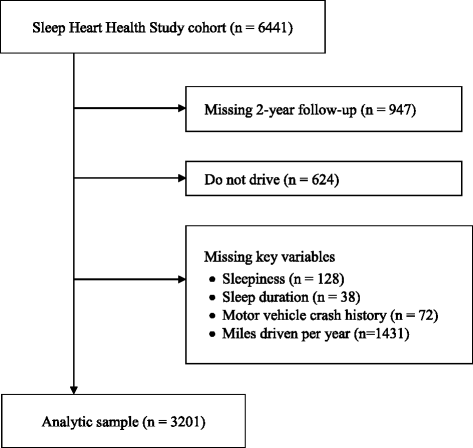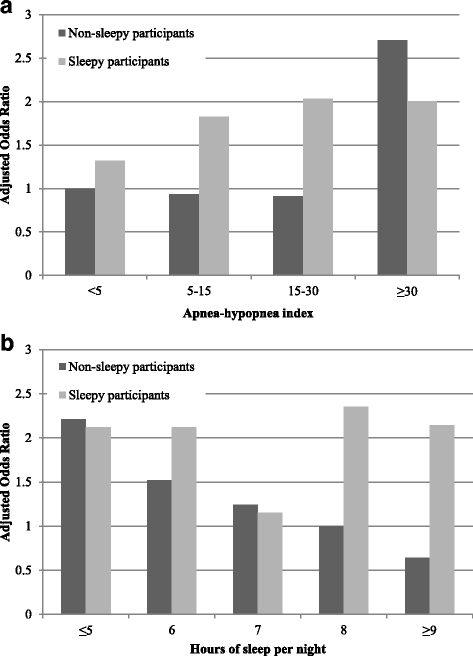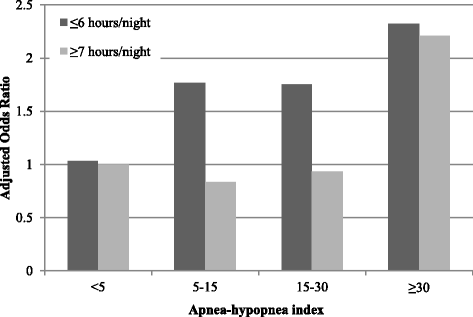Sleep deficiency and motor vehicle crash risk in the general population: a prospective cohort study
- PMID: 29554902
- PMCID: PMC5859531
- DOI: 10.1186/s12916-018-1025-7
Sleep deficiency and motor vehicle crash risk in the general population: a prospective cohort study
Abstract
Background: Insufficient sleep duration and obstructive sleep apnea, two common causes of sleep deficiency in adults, can result in excessive sleepiness, a well-recognized cause of motor vehicle crashes, although their contribution to crash risk in the general population remains uncertain. The objective of this study was to evaluate the relation of sleep apnea, sleep duration, and excessive sleepiness to crash risk in a community-dwelling population.
Methods: This was a prospective observational cohort study nested within the Sleep Heart Health Study, a community-based study of the health consequences of sleep apnea. The participants were 1745 men and 1456 women aged 40-89 years. Sleep apnea was measured by home polysomnography and questionnaires were used to assess usual sleep duration and daytime sleepiness. A follow-up questionnaire 2 years after baseline ascertained driving habits and motor vehicle crash history. Logistic regression analysis was used to examine the relation of sleep apnea and sleep duration at baseline to the occurrence of motor vehicle crashes during the year preceding the follow-up visit, adjusting for relevant covariates. The population-attributable fraction of motor vehicle crashes was estimated from the sample proportion of motor vehicle crashes and the adjusted odds ratios for motor vehicle crash within each exposure category.
Results: Among 3201 evaluable participants, 222 (6.9%) reported at least one motor vehicle crash during the prior year. A higher apnea-hypopnea index (p < 0.01), fewer hours of sleep (p = 0.04), and self-reported excessive sleepiness (p < 0.01) were each significantly associated with crash risk. Severe sleep apnea was associated with a 123% increased crash risk, compared to no sleep apnea. Sleeping 6 hours per night was associated with a 33% increased crash risk, compared to sleeping 7 or 8 hours per night. These associations were present even in those who did not report excessive sleepiness. The population-attributable fraction of motor vehicle crashes was 10% due to sleep apnea and 9% due to sleep duration less than 7 hours.
Conclusions: Sleep deficiency due to either sleep apnea or insufficient sleep duration is strongly associated with motor vehicle crashes in the general population, independent of self-reported excessive sleepiness.
Keywords: Epidemiology; Motor vehicle accident; Motor vehicle crash; Sleep apnea; Sleep deficiency; Sleep deprivation; Sleep duration.
Conflict of interest statement
Ethics approval and consent to participate
The protocol was approved by the institutional review board of each participating center and signed informed consent was provided by each participant. The IRB/Human Subjects Committee protocol numbers are as follows: Boston University School of Medicine: H-22384 Johns Hopkins University: H.34.94.05.23.A University of Minnesota: 9406M8378 New York University: H8185 University of Pittsburgh: 9406129 University of California at Davis: 200210023 University of Arizona: 94-0248-01.
Consent for publication
Not applicable.
Competing interests
DJG has received consulting fees or served as a paid member of scientific advisory boards for ResMed Corporation, VIVUS, Inc., and T. Leland Seeger & Associates, Inc.
JME has received consulting fees from Bose Corporation and Invenergy Renewables.
MTB has received funding from the Center for Integration of Medicine and Innovative Technology, the Milton Family Foundation, the MGH-MIT Grand Challenge, the American Sleep Medicine Foundation, and the Department of Neurology. He has a patent pending on a home sleep-monitoring device, has research agreements with MC10 and Insomnisolv, consulting agreements with McKesson, International Flavors and Fragrances, and Apple, Inc., serves as a medical monitor for Pfizer, and has provided expert testimony in sleep medicine. None of these entities had any role in the study.
CAC has received consulting fees from or served as a paid member of scientific advisory boards for Bose, Boston Red Sox, Columbia River Bar Pilots, Institute of Digital Media and Child Development, Purdue Pharma, Samsung, and Vanda Pharmaceuticals. He owns an equity interest in Vanda Pharmaceuticals. He has served as an expert witness on various legal cases related to sleep and circadian rhythms and he has received research support from Optum, San Francisco Bar Pilots, Schneider, Sysco, Philips Respironics, Vanda Pharmaceuticals, and the State of Washington Board of Pilotage Commissioners. The Harvard Medical School Sleep and Health Education Program and Brigham Sleep Health (CAC) have received funding for educational activities from Cephalon, Jazz Pharma, ResMed, Takeda Pharmaceuticals, Sanofi-Aventis, Sepracor, Simmons, and Mary Ann & Stanley Snider via Combined Jewish Philanthropies. CAC is the incumbent of an endowed professorship provided to Harvard University by Cephalon, and holds several process patents in the specialty of sleep and circadian rhythms (e.g., photic resetting of the human circadian pacemaker). CAC has received royalties from Houghton Miflin Harcourt, and from Koninklijke Philips Electronics/Philips Respironics for the Actiwatch-2 and Actiwatch Spectrum devices. CAC’s interests were reviewed and are managed by Brigham Health and Partners HealthCare in accordance with their conflict of interest policies.
Publisher’s Note
Springer Nature remains neutral with regard to jurisdictional claims in published maps and institutional affiliations.
Figures



Similar articles
-
Injury crashes and the relationship with disease causing excessive daytime sleepiness.Traffic Inj Prev. 2021;22(4):272-277. doi: 10.1080/15389588.2021.1894639. Epub 2021 Mar 26. Traffic Inj Prev. 2021. PMID: 33769162
-
Excessive daytime sleepiness increases the risk of motor vehicle crash in obstructive sleep apnea.J Clin Sleep Med. 2013 Oct 15;9(10):1013-21. doi: 10.5664/jcsm.3072. J Clin Sleep Med. 2013. PMID: 24127145 Free PMC article.
-
Insufficient sleep rather than the apnea-hypopnea index can be associated with sleepiness-related driving problems of Japanese obstructive sleep apnea syndrome patients residing in metropolitan areas.Sleep Med. 2017 May;33:19-22. doi: 10.1016/j.sleep.2016.07.022. Epub 2016 Sep 5. Sleep Med. 2017. PMID: 28449900
-
Obstructive sleep apnea syndrome: assessing and managing risk in the motor vehicle operator.Curr Opin Pulm Med. 2011 Nov;17(6):412-8. doi: 10.1097/MCP.0b013e32834b96a4. Curr Opin Pulm Med. 2011. PMID: 21921796 Review.
-
[Sleepiness among adolescents: etiology and multiple consequences].Encephale. 2023 Feb;49(1):87-93. doi: 10.1016/j.encep.2022.05.004. Epub 2022 Aug 12. Encephale. 2023. PMID: 35970642 Review. French.
Cited by
-
Myofunctional therapy (oropharyngeal exercises) for obstructive sleep apnoea.Cochrane Database Syst Rev. 2020 Nov 3;11(11):CD013449. doi: 10.1002/14651858.CD013449.pub2. Cochrane Database Syst Rev. 2020. PMID: 33141943 Free PMC article.
-
Global warming may increase the burden of obstructive sleep apnea.Nat Commun. 2025 Jun 16;16(1):5100. doi: 10.1038/s41467-025-60218-1. Nat Commun. 2025. PMID: 40523909 Free PMC article.
-
Sleep and circadian informatics data harmonization: a workshop report from the Sleep Research Society and Sleep Research Network.Sleep. 2022 Jun 13;45(6):zsac002. doi: 10.1093/sleep/zsac002. Sleep. 2022. PMID: 35030631 Free PMC article.
-
What Is the Link Between Attention-Deficit/Hyperactivity Disorder and Sleep Disturbance? A Multimodal Examination of Longitudinal Relationships and Brain Structure Using Large-Scale Population-Based Cohorts.Biol Psychiatry. 2020 Sep 15;88(6):459-469. doi: 10.1016/j.biopsych.2020.03.010. Epub 2020 Mar 31. Biol Psychiatry. 2020. PMID: 32414481 Free PMC article.
-
Interhemispheric sleep depth coherence predicts driving safety in sleep apnea.J Sleep Res. 2021 Apr;30(2):e13092. doi: 10.1111/jsr.13092. Epub 2020 May 22. J Sleep Res. 2021. PMID: 32441843 Free PMC article.
References
-
- National Center on Sleep Disorders Research. National Institutes of Health Sleep Disorders Research Plan; NIH Publication No. 11–7820; November 2011.
-
- Colten HR, Altevogt BM, editors. Sleep disorders and sleep deprivation: an unmet public health problem. Washington, D.C.: The National Academies Press; 2006. - PubMed
Publication types
MeSH terms
Grants and funding
- R01 HL095472/HL/NHLBI NIH HHS/United States
- GM105018/GM/NIGMS NIH HHS/United States
- U01 HL053916/HL/NHLBI NIH HHS/United States
- U01 HL063463/HL/NHLBI NIH HHS/United States
- R01 HL094654/HL/NHLBI NIH HHS/United States
- HL095472/HL/NHLBI NIH HHS/United States
- U01 HL053938/HL/NHLBI NIH HHS/United States
- U01 HL064360/HL/NHLBI NIH HHS/United States
- U01HL111478/HL/NHLBI NIH HHS/United States
- U01 HL053941/HL/NHLBI NIH HHS/United States
- U01 HL111478/HL/NHLBI NIH HHS/United States
- R01 GM105018/GM/NIGMS NIH HHS/United States
- P01AG009975/AG/NIA NIH HHS/United States
- P01 AG009975/AG/NIA NIH HHS/United States
- U01 HL053934/HL/NHLBI NIH HHS/United States
- U01 HL063429/HL/NHLBI NIH HHS/United States
- U01 HL053937/HL/NHLBI NIH HHS/United States
- U01HL53941/HL/NHLBI NIH HHS/United States
- U01 HL053931/HL/NHLBI NIH HHS/United States
- HL94654/HL/NHLBI NIH HHS/United States
LinkOut - more resources
Full Text Sources
Other Literature Sources
Medical

